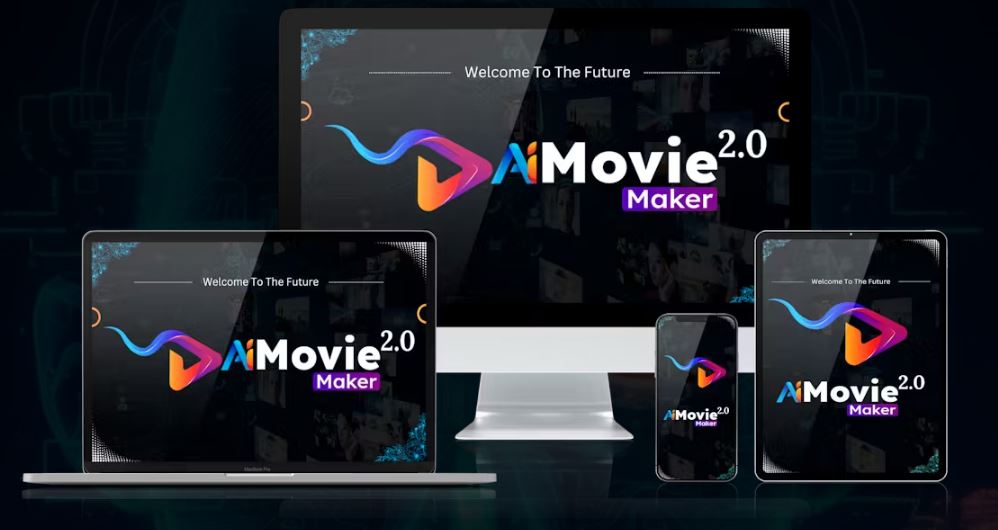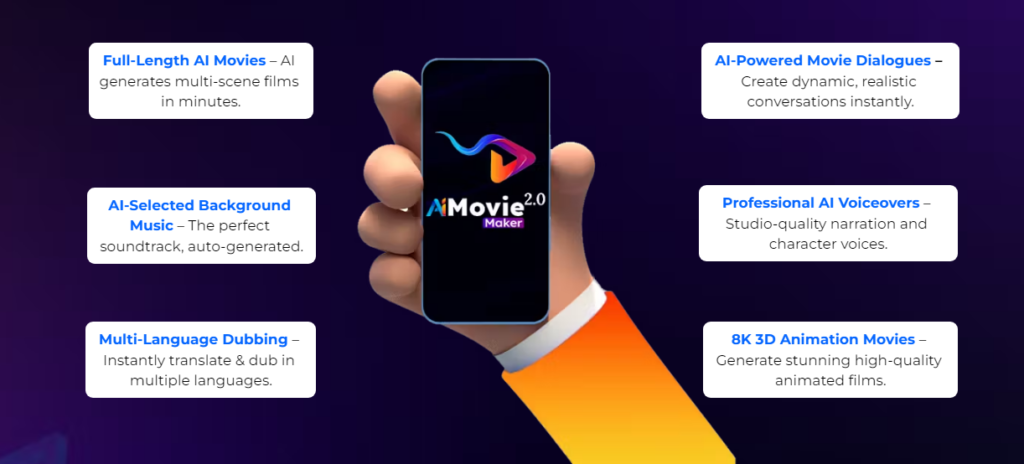
Harness the power of AI to create stunning 8K cinematic movies with a single prompt using Ai MovieMaker 2.0.
Ai MovieMaker 2.0 changes how we make movies. It turns simple ideas into full-length films with just one prompt. You don’t need fancy equipment or know-how to make 8K resolution movies anymore.
This tech makes it easy to bring stories to life. Whether it’s action scenes or emotional dramas, ai moviemaker 2.0 makes it simple. It turns your ideas into scenes that look amazing, just like in 8K movies.
Discover how ai moviemaker 2.0 brings your dreams to life. This article dives into the tech, how to write great prompts, and real examples. See how anyone can make top-notch films without the usual hurdles.

Key Takeaways
- ai moviemaker 2.0 creates 8K cinematic movies from one written prompt.
- No prior filmmaking experience is required to generate professional-quality content.
- Technology reduces costs and time compared to traditional production methods.
- Cinematic movies now accessible to indie filmmakers, educators, and businesses.
- Learn prompt optimization techniques to maximize AI-generated film results.
The Revolution of AI-Powered Filmmaking
Artificial intelligence is changing how we tell stories. What used to take years and millions of dollars now takes just minutes. This change is making creativity, access, and filmmaking itself different.
How AI Is Transforming the Film Industry
AI is making editing faster. Tasks like color correction and sound design are now automated. This means studios can save money without losing quality.
Even indie filmmakers are using AI to improve their work quickly. Tools like DaVinci Resolve and Adobe Premiere Pro’s AI features help them in hours, not weeks.
The Emergence of One-Prompt Movie Creation
AI has come a long way from simple text-to-image models. Now, it can understand complex ideas and turn them into scenes. This is a big step forward in artificial intelligence video editing.
Breaking Down the Barriers to Professional Filmmaking
Filmmaking used to be expensive and require a lot of technical knowledge. But now, things are changing:
- Cost: Cloud-based AI tools make it cheaper to start.
- Team Size: One person can make a movie with easy-to-use tools.
- Knowledge: You don’t need to know how to code to make a movie.
This means new filmmakers can focus on their ideas, not just how to make them.
Introducing Ai MovieMaker 2.0: A Complete Overview
Ai MovieMaker 2.0 is a game-changer. It combines ai moviemaker features into one platform. It’s made for creators, offering scriptwriting, visual rendering, and sound design all in one place. This system uses AI to handle every step of making a movie, from start to finish in 8K quality.
- Single-prompt film generation with adaptive AI
- 8K resolution rendering without manual pixel adjustments
- Automated soundscapes and background music generation
- Drag-and-drop scene reordering and timeline editing
| Feature | Ai MovieMaker 2.0 | Traditional Tools |
|---|---|---|
| Prompt-based creation | Full movie generation from text input | Requires manual scene scripting |
| Resolution quality | Native 8K output | Upgrades require paid plugins |
| Learning curve | Intuitive interface for beginners | Requires technical training |
Ai MovieMaker 2.0 is the best movie editing tool out there. It cuts production time by 70% compared to old ways. You can get cloud-based rendering power for $29/month. This all-in-one tool lets creators focus on their art, not technical problems.
The Technology Behind Creating 8K Cinematic Quality
Every frame of cinematic movies is made with advanced tech. This part talks about how AI MovieMaker 2.0 gets stunning 8K quality and realism. It looks at its main systems.
Understanding 8K Resolution and Its Benefits
8K has 7680×4320 pixels, four times more than 4K. This high resolution keeps images sharp, even on big screens. The benefits are:
- Unmatched detail for close-ups and wide shots
- Scalability for different screen sizes
- Future-proofing content for emerging display tech
Neural Rendering Techniques for Realistic Visuals
AI uses neural networks to mimic real-world lighting and textures. Key techniques include:
| Technique | Description |
|---|---|
| Diffusion models | Generate pixel patterns mimicking natural scenes |
| Style transfer | Apply cinematic aesthetics to visuals |
| Scene coherence | Ensures smooth transitions between frames |
How AI Processes and Interprets Creative Prompts
Natural language processing (NLP) breaks down user inputs into visual parameters. For example:
A prompt like “sunset over a desert” triggers algorithms to select color palettes, lighting angles, and sand texture databases.
The Computational Requirements for 8K Generation
Rendering 8K needs strong hardware. Options include:
- GPU clusters with 32GB+ VRAM
- Cloud-based processing for remote access
Those without top-notch GPUs can use cloud solutions. This keeps video creation with ai technology accessible.
Crafting the Perfect Prompt for Your AI Masterpiece
Getting the most out of ai moviemaker 2.0 starts with clear instructions. This movie making software needs well-structured prompts to create stories. Finding the right balance between specific details and creativity is key.
Prompt Engineering Fundamentals for Filmmakers
Prompt design is a mix of technical skill and creative vision. Begin by setting the main themes but also give the AI some room to be creative. For instance, saying “a dystopian city under perpetual rain” sets the scene without getting too detailed. Stay away from vague terms like “abstract” or “unique.”
Structural Elements to Include in Your Movie Prompt
| Element | Description |
|---|---|
| Plot | Outline major events and turning points. |
| Visual Style | Reference genres (e.g., noir, cyberpunk) or lighting preferences. |
| Tone | Specify mood keywords like “tense” or “melancholic.” |
Common Pitfalls to Avoid When Designing Prompts
- Overloading with technical jargon unrelated to storytelling
- Ignoring pacing instructions, causing disjointed timelines
- Conflicting details (e.g., “modern tech in a medieval setting”)
Getting good at creating prompts can make ai moviemaker 2.0 a powerful tool. Try different prompts to see what works best.
From Concept to Screen: The Ai MovieMaker 2.0 Workflow
Starting a film with Ai MovieMaker 2.0 is easy. Just give a simple prompt. The software uses artificial intelligence video editing to turn your idea into scenes. The whole process is divided into four main steps: concept, iteration, refinement, and delivery.
- Concept Phase: Start by describing your film’s theme, genre, and tone. The AI will then show you initial scene thumbnails for you to approve.
- Iteration: Use the real-time preview tool to tweak pacing, lighting, or character expressions before the final render.
- Refinement: Use ai moviemaker features like selective scene regeneration and sound mixing to fine-tune your final product.
- Delivery: Export your film in 8K or 4K for platforms like Netflix or YouTube.
Collaboration tools allow teams to edit together. There’s a version history to track changes, and a shared feedback board for remote teams to make suggestions. The auto-synchronize function keeps all edits up to date across devices.
In post-production, you can make manual changes for exact control. You can override AI suggestions in the timeline editor. This mix of automated and manual work lets you have creative freedom while keeping things fast. Whether it’s a short film or a big feature, the workflow fits any project size.
Advanced Features That Set Ai MovieMaker 2.0 Apart
Ai MovieMaker 2.0 stands out with its special tools for creativity. Its ai script organizer helps with story structure, making plots smoother and characters more interesting. It also checks dialogue and themes, keeping stories on track.
AI Script Organizer and Story Development Tools
The ai script organizer helps with story outlines, spots issues, and suggests new scenes. It lets users compare different versions of their story. It also predicts what parts will grab the audience’s attention, making scenes more impactful.
3D Animation Integration Capabilities
It’s easy to mix live-action with 3d animation movies thanks to neural rendering. The platform’s engine combines real backgrounds with animated characters. This makes fantasy scenes feel like part of the real world. Users can tweak textures and lighting for a perfect look.
Sound Design and Musical Score Generation
- Generate adaptive scores that shift tempo/dynamics with on-screen action
- Automated Foley effects library for precise scene ambiance
- AI-curated royalty-free music tracks aligned to emotional beats
Character and Environment Customization Options
Design characters with facial sliders and motion-capture options. Environments can be created with keywords like “post-apocalyptic city” or “steampunk laboratory.” Users can adjust scale and material physics for a realistic feel.
Real-World Applications and Success Stories
Ai MovieMaker 2.0 has changed how we make videos, helping people all over the world. It’s used by both small filmmakers and big companies.
Independent Filmmakers Breaking Through with AI
Director Alex Chen made a big splash with *“Neon Pulse”*, a sci-fi short at Sundance 2023. The AI helped cut down editing time by half. Chen could now focus on the story.
“The best movie editing tool let me work on 8K visuals in hours, not weeks,” Chen said. The film’s AI-made settings got great reviews. It showed indie films can now match big studio budgets.
Commercial and Marketing Applications
Big companies use Ai MovieMaker 2.0 for quick marketing. A tech startup saved 65% on ads by using AI. Car brands show off new cars in detailed settings.
E-commerce sites make product demos fast. GreenTech Solutions saw a 200% return on investment with AI ads.
Educational Uses of AI-Generated Films
Universities like MIT use Ai MovieMaker 2.0 in film classes. Students make historical dramas or explain quantum physics. A Stanford study showed 85% of students learned more from AI videos than lectures.
Medical schools use it for 3D surgery training. It helps surgeons practice in a safe way.
Comparing Ai MovieMaker 2.0 to Traditional Filmmaking Methods
Choosing between AI tools like Ai MovieMaker 2.0 and traditional filmmaking has its pros and cons. This comparison looks at three main areas where Ai MovieMaker changes filmmaking.
Cost Analysis: AI vs. Conventional Production
Traditional filmmaking can cost over $50,000 for equipment, crew, and locations. Ai MovieMaker 2.0 offers a subscription starting at $29/month. It eliminates the need for expensive rentals and union fees, making high-quality movies affordable.
Time Efficiency: From Months to Hours
- Traditional: Scriptwriting → casting → filming → editing → post-production (6–12 months)
- Ai MovieMaker 2.0: Write a prompt → generate scenes → refine output → finalize (4–48 hours)
Teams save weeks by skipping physical shoots and labor-intensive editing.
Creative Control: Limitations and Possibilities
Ai MovieMaker 2.0 is great for quick prototypes but needs clear prompts for the best results. Human filmmakers have full control over dialogue and direction but work slower. The AI is strong in creating visual concepts and cinematic movies drafts, while humans add the nuanced storytelling.
Both methods work together in today’s filmmaking. Studios use Ai MovieMaker 2.0 for storyboarding, while traditional techniques handle the final touches. The choice depends on the project’s scope, budget, and creative goals.
Conclusion: The Future of Cinematic Creation in the Age of AI
AI tools like Ai MovieMaker 2.0 are changing how we tell stories. They offer features like ai script organizer software and artificial intelligence video editing. This lets filmmakers create high-quality 8K films without needing a lot of money or technical skills.
New trends show even more exciting changes coming. Better neural networks could make visuals more realistic and make editing easier. Creators might also be able to turn ideas into scenes more accurately. But, there are still challenges like copyright issues and changes in the film industry.
Using AI tools means working together with machines. Creators need to learn how to give clear instructions and use ai script organizers. This helps them improve their work. Artificial intelligence video editing also makes making movies faster, allowing for more creativity.
The future of AI in filmmaking is about finding a balance. AI should help, not replace, human creativity. This way, filmmakers can focus on telling stories, knowing technology has their backs. This change opens up filmmaking to more people, keeping it a vibrant and inclusive art form.
FAQ
What is AI MovieMaker 2.0?
AI MovieMaker 2.0 is a top-notch movie making software. It uses artificial intelligence to create stunning 8K films from just one prompt. It has AI for writing scripts, making visuals, and designing sounds, making it easy for all creators.
How does AI enable 8K resolution in movies?
AI MovieMaker 2.0 uses neural rendering for 8K content. This ensures clear and detailed visuals. It uses deep learning to make images look real, giving viewers a better movie experience.
What are the benefits of using AI for video creation?
AI saves a lot of time and cuts costs. It also makes high-quality videos fast. AI MovieMaker 2.0 makes filmmaking easy for everyone, not just experts.
Can I create 3D animation movies with AI MovieMaker 2.0?
Yes, AI MovieMaker 2.0 lets you mix real and 3D animations. This adds a unique look to your stories, making them more engaging.
What types of projects is AI MovieMaker 2.0 suitable for?
AI MovieMaker 2.0 works for many projects. This includes indie films, ads, educational videos, and more. It’s flexible for all kinds of creative needs.
How do I craft a prompt for AI MovieMaker 2.0?
A good prompt is specific but also open to creativity. Include the story, characters, setting, and mood. Avoid vague descriptions for the best results.
What features set AI MovieMaker 2.0 apart from other editing tools?
AI MovieMaker 2.0 has unique features like an AI script organizer and advanced sound design. It also lets you customize characters and environments. These tools help create immersive movies.
How can I assess the cost-effectiveness of AI MovieMaker 2.0?
Compare AI MovieMaker 2.0’s costs to traditional filmmaking. Look at fees, equipment, crew, and location costs. This helps decide if AI is more cost-effective for your project.
What are some real-world applications of AI MovieMaker 2.0?
AI MovieMaker 2.0 has helped indie filmmakers win awards, businesses create cool ads, and educators make learning fun. It shows how versatile AI can be.






